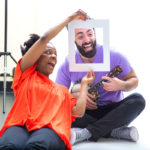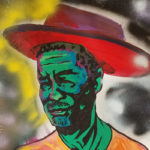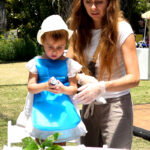PAMM Art Detectives Program
Marie Vickles: Art Detectives is a partnership between the Perez Art Museum, Miami, Breakthrough Miami, the Links Incorporated of greater Miami and the Miami-Dade County Police Department.
Donna Ginn: Good afternoon, I’m Donna Ginn, I’m with the greater Miami Chapter of the Links Incorporated and we are a women’s organization who serves our community through five facets. This project, Art Detectives is through our arts program as you might imagine.
Marie Vickles: This program was put together with the goal of creating and promoting a space for critical dialogue between youth and police.
Chire Regans: On behalf of the Perez Museum I would like to welcome you all to the first of three days of interactions that we’re gonna have with the Art Detectives program.
Loni Johnson: We’re establishing a safe space together, we need to establish what the norms and the non-negotiables are. So these are things that are going to stand in this room to keep our space safe, yeah?
Chire Regans: A safe space is a space where you’re not concerned about judgment, you’re not concerned about what someone’s response to your honesty is going to be. So you can be completely honest about things you may not have admitted before and you can do this with other people who may have those same insecurities about being honest about their feelings. Especially in the presence of law enforcement.
Loni Johnson: So if there’s any of time where any of us is falling out of line of this, we can be like hey, uh-uh, you can refer back to this and say no, no, no, we said no judgment.
Chire Regans: Because usually when you see law enforcement someone’s in trouble. So for them to be able to understand that this is a safe space for you and you have memories of law enforcement there, they really took advantage of that because they asked the members of law enforcement questions that they probably hadn’t heard before and they had to answer those questions.
Girl1: They said because we were in the area, they assumed my mom was just buying drugs so that’s why I put targeted violence. Like what point is there to put a gun on a eight year old.
Officer Cheryl: I feel empathy toward you, I’m sorry that that happened to you and that’s an unfortunate circumstance but our officers shouldn’t be viewed as what you see in the media. Most of the officers are loving, caring and that’s what we chose to do, we chose to protect and serve our community.
Male Police 1: There’s a small kid named Errol, and Errol which out of the blue we happened to be working one of our details in our parks and we happened to see Errol, he comes up to us, he says hi, he’s not scared to approach us in the neighborhood when half of the other kids would walk away. So next time we’re at the park, we see Errol, Errol comes up with another kid and they say hi and they engage and then they see that it’s okay to approach us and talk to us in the neighborhood where 99.9% of the kids and even the parents don’t want nothing to do with us.
Officer Cheryl: Once everyone started to get to know each other and start to trust each other, then at that point I think we could be able to work cohesively and effectively and it was just an enjoyable experience through the arts.
Male Officer 2: We were in the same [inaudible 00:03:22] so that means you didn’t remember our names.
Speaker 10: Rose … no no no, I’m [inaudible 00:03:28]. Not Nya. But this is Melody.
Marie Vickles: We’re going to be looking at artwork in the permanent collection. We’re going to be talking about that work, talking about how it connects to life, how it connects to everyday experiences and just working on growing our critical skills and observation.
Male Officer 2: You eat your Wheaties?
Speaker 12: Come on in.
Chire Regans: And you see how when you first approach artwork, your interpretation could be completely different than someone else’s or even what the artist intended, right? But it doesn’t make it wrong.
Chire Regans: And so you see we have law enforcement here, and you know how everyone can have a different interpretation of law enforcement just like they can have a different interpretation of you all it doesn’t make it wrong, right? You just have to take the time to figure out the truth.
Speaker 13: Really the entire thing looks kinda like something that say like a fifty year old man or like my dad would have.
Chire Regans: [inaudible 00:04:33] to you.
Girl2: That’s like in like the shape of like a boat and then there’s words on it, and it says export, and looks kind of like there’s a lot of creativity … things you could do inside of the boat.
Male Officer 2: They’re participating and I don’t know some of the stuff, and they don’t, so when we all kind of brainstorm and come together and learn.
Tracey: You’re starting to see that it’s more natural how these relationships are being built. Not only between the police and the children, but even with the museum and the community and our service organization, Links Inc. and breakthrough and just to see as we come in together [crosstalk 00:05:17].
Webber: The walls have been kind of deconstructed and now you kind of see a synergy between the 3 or 4 agencies that are involved.
Loni Johnson: So we want you guys to put in imagery whatever way you feel fit, your response to your experience so far.
Officer Cheryl: I think they’re starting to get to know us so we’re starting to build a rapport, a better rapport. So, they feel more comfortable with us.
Loni Johnson: I would like for you guys with this activity, I want you to think of one person … yes I said one, one person that you would like the world to be safe for and then I want you to also think about why you want the world to be safer for them and how you can make the world safer for them.
Chire Regans: It’s natural for you to want to protect everyone. When you’re young you’re just like that, you want to protect everyone. But you have to think about who do I need to protect now, and why. And then hearing from law enforcement who they want to protect, you may have a similar person in your life that you want to protect. So that’s how you build familiarity.
Speaker 19: I put Jamesia.
Loni Johnson: You put who, Jamesia? Who is that?
Speaker 19: My mom.
Loni Johnson: Your mom.
Speaker 19: Yeah.
Male Officer 2: That could be your name. And how I can make that safer for you, make it safer for you as in my line of work and my other works that I do as far as the country as well, I’m also a soldier. That we deal with things so that you guys don’t have to do the things that make things better for you.
Speaker 21: I put my brother, Isaiah because sometimes like me, he’s a very shy person. And since he’s shy, he doesn’t really stand up for himself.
Officer Cheryl: I chose my dad, his name is Issac. He’ll be 92 in a couple of weeks. He’s very independent. He lives with me, so I take care of my dad. What else do we believe? Do we believe in something?
Loni Johnson: I’ve done that manifesto activity in all types of communities, and you can see in them how it empowers them and how they take ownership. But it is a collection of ideas, of demands, of wants, of desires.
Speaker 22: People should not be bullied, verbally threatened, nor physically cyberbullied because that’s just not a good thing and we should respect them.
Speaker 23: We believe if we stop violence we will have peace.
Loni Johnson: How can we give them something to walk away with instead of just the manifestos? How can we teach them this idea of spreading a message? And these are the easiest way to do that, so we were like “Why don’t we just create one for them to kind of give them the template and they can just take that [crosstalk 00:08:33] anywhere.”
Chire Regans: I take away that me as an adult, I have my views about law enforcement based on my experiences. And so for me to relate to youth who are coming into those experiences maybe. Some of them were very unbiased, some of them were biased but I had to interact with each one of them the same way. And I had to deliver information about law enforcement without my bias. So I had to take myself out of it and give them raw information and let them make their own judgment.
Marie Vickles: This program has grown in many ways. We have seen a space for youth and police to come together, to dialogue. All jump-started around these conversations sparked by contemporary art. They’re looking at art, they’re creating their own art and then the conversations are coming.
Webber: They’ve had their first opportunity to be around a police officer that wasn’t angry, that wasn’t pulling somebody over, that wasn’t addressing a domestic violence phone call, wasn’t addressing a gun violence issue in their community. So they actually had a chance to see a cop laugh, a cop joke around, a cop be sensitive, a cop reveal personal matters.
Officer Cheryl: I would like to see more programs like this incorporated within our community which … the community I serve which is Miami-Dade Country so that we can break the fears like some of the children stated that it was a fear of being around us.
Loni Johnson: A lot of times young people aren’t asked to be accountable for what they do, and I can say the same for law enforcement. A lot of times because they are the authority, they’re not held accountable for what they do, so it’s very important for people to recognize that.
Chire Regans: These are kids who are going out into the world in a few years and they’re gonna be in situations with law enforcement, probably fairly frequently depending on where they’re from. They can take this experience and apply it to other situations and interactions they have with law enforcement.









